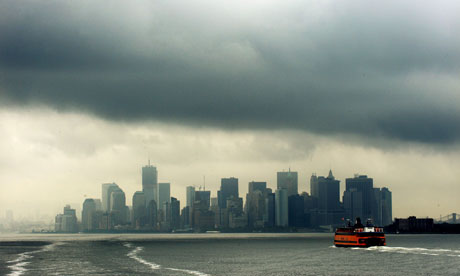Major storms could submerge New York City in next decade.
Sea-level rise due to climate change could cripple the city in Irene-like storm scenarios, new climate report claims

The Manhattan skyline as Hurricane Irene approached. Photograph: KeystoneUSA-Zuma/Rex Features
Irene-like storms of the future would put a third of New York City streets under water and flood many of the tunnels leading into Manhattan in under an hour because of climate change, a new state government report warns Wednesday.
Sea level rise due to climate change would leave lower Manhattan dangerously exposed to flood surges during major storms, the report, which looks at the impact of climate change across the entire state of New York, warns.
"The risks and the impacts are huge," said Art deGaetano, a climate scientist at Cornell University and lead author of the ClimAID study. "Clearly areas of the city that are currently inhabited will be uninhabitable with the rising of the sea."
Factor in storm surges, and the scenario becomes even more frightening, he said. "Subway tunnels get affected, airports -- both LaGuardia and Kennedy sit right at sea level -- and when you are talking about the lowest areas of the city you are talking about the business districts."
The report, commisioned by the New York State Energy Research and Development Authority, said the effects of sea level rise and changing weather patterns would be felt as early as the next decade.
By the mid-2020s, sea level rise around Manhattan and Long Island could be up to 10 inches, assuming the rapid melting of polar sea ice continues. By 2050, sea-rise could reach 2.5 ft. and more than 4.5 ft. by 2080 under the same conditions.
In such a scenario, many of the tunnels -- subway, highway, and rail -- crossing into the Bronx beneath the Harlem River, and under the East River would be flooded within the hour, the report said. Some transport systems could be out of operation for up to a month.
The report, which was two years in the making, was intended to help the New York state government take steps now to get people out of harm's way -- and factor climate change into long-term planning to protect transport, water and sewage systems.
New York mayor Michael Bloomberg was so concerned that he went on to commission an even more detailed study of the city after receiving early briefings on the report.
New York mayor Michael Bloomberg was so concerned that he went on to commission an even more detailed study of the city after receiving early briefings on the report.
That makes him an outlier among his fellow Republicans, who blocked funds for creating a new climate service in budget negotiations in Congress this week.
DeGaetano said climate change would force governments to begin rethinking infrastructure. Most of New York City's power plants, water treatment plants, and sewage systems are right at sea level.
City planners are also going to have to help people adapt. More than half a million people live in the New York flood plain, and, as the report noted, a significant portion of them are African American and Latinos.
And floods are not the only potential danger of climate change. The report notes that New York could face average annual temperature rises of up to 5 degrees Fahrenheit by the middle of this century and by as much as 9 degrees by 2080.
And floods are not the only potential danger of climate change. The report notes that New York could face average annual temperature rises of up to 5 degrees Fahrenheit by the middle of this century and by as much as 9 degrees by 2080.
In summer months, this could subject New Yorkers to power shortages and the risk of black-outs because of the extra need for air conditioning. Those without air conditioning -- or who can not afford the higher electricity bills -- would be at greater risk of heat stroke.
Those hotter conditions would have effects right across the state, playing havoc with New York state's wine and agricultural industries. Spruce and Fir trees would disappear form the Catskills and West Hudson River Valley, dairy cows would suffer heat stress, and popular apple varieties would decline, the report said.







No comments:
Post a Comment